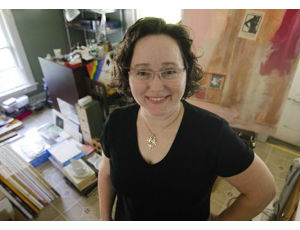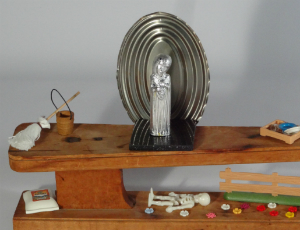Our Lady of Perpetual Housework will be on display for Women's History Month, March 1-31, at the West Englewood Branch.
Q: As a busy mother of three, how do you find time to do your artwork?
A: An artist friend of mine said, "I figured it out – you make art to stay sane, don't you?" A UK artist, Nicki Rolls, addressed this in the Guardian.
But to answer the question more literally, I work all day on Sundays plus one more day per month. I can also sneak up to my studio in stolen moments here and there. And I do little things, like my Through the Windshield photo series, where I've committed to carrying a camera with me all the time. It's a small thing, but it keeps me observing.
My husband/volunteer photographer is wonderfully supportive, and my kids are my biggest fans. My 14-year-old daughter has great taste, and I value her feedback. Being an artist takes a lot of support; you're working with little in the way of sales or positive feedback, so having family support is part of what keeps me going.
Q: What role does art play in your life?
A: Art therapy, to an extent. What's interesting is that often I'll make something that deals with an issue, like my medals series. I made two medals about disappointment; one of them actually said on the medal, "I expected more of myself by now," and then after that, I released it. Once I put that idea into those pieces, it was gone and I moved on.
Beyond that, it's my life's work, my career. I've taught jewelry making and art and now, at long last, I'm focusing on making and selling jewelry and art.
Q: What made you choose "assemblage" as your medium?
A: Lack of other skills! I wanted to sculpt it, but don't have the skills. Rather than wait years to get good enough, I said, okay, what can I do now? How can I bring this idea to fruition now?
I also do collage, so I seem to be re-mixer. I used to feel kind of badly about that until I read a blog post by Luann Udell about the value of collecting and curating in artwork. That, and seeing all the artists who do have drawing and realistic painting chops and choose not to use them. I guess I came to peace with it.
Q: In your pieces, the woman is portrayed as a saint surrounded by housework. Do you think that motherhood requires a degree of saintliness?
A: You know, I made the first one back in 2010 and I hadn't thought of it like that really. But I recently attended a day of panels on motherhood and art put on by the Feminist Art Project, and after that I realized that saints become saints because they're martyrs and self-sacrificing. Mothers are expected to be self-sacrificing, and I think that sometimes I feel like I'm not self-sacrificing enough, that I don't measure up as a mom. (Of course, none of us do, because the expectations are too high.)
Q: You say these pieces are a plea for help. Are they also a protest?
A: Probably. Especially if you look at "Our Lady of Perpetual Housework," which includes the mice and the skeleton on the lower level. The skeleton is about the idea that it's not over until you die. That one is the darkest of all of them.
What I like about them, though, is how people react to these pieces—everyone smiles, or smiles and laughs. I love that. I've also made lots of serious work that connects with people on a deeper level about grief and loss, which is wonderful. I'm glad to be making things now that make people smile.



